A Comics Guide to the Best of Black Panther: Wakanda Forever’s Namor
(Photo: Marvel Studios)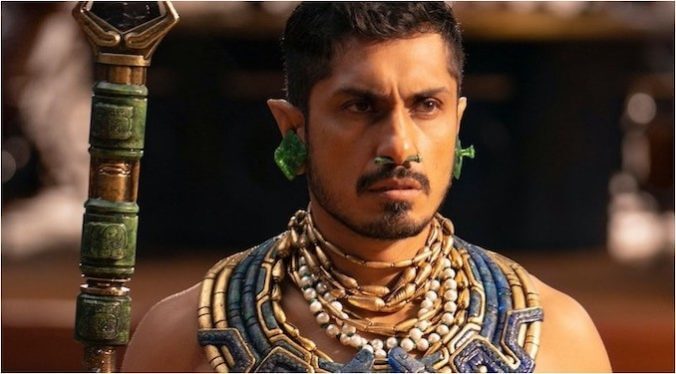
Marvel Comics’ first superhero before the company was even established, Namor the Sub-Mariner was created by writer, artist, and comic book legend Bill Everett during the golden age of superheroes. In 1939, Superman had captured the imaginations of comic book fans and competing publishers were looking to cash in on the trend. Alongside editor and entrepreneur Lloyd Jacquet, Everett was a driving creative force at the newly established comic publisher First Funnies Inc. and was tasked with creating a hero to compete with the Man of Steel. While Jacquet’s idea of printing and selling hero-centric comics at theaters proved unsuccessful, the company rebranded a few months later as Funnies Inc. and teamed up with Martin Goodman, head of Timely Comics (the forerunner to Marvel Comics) to print the first of many superhero tales in Marvel Comics #1.
“Here is the Sub-Mariner.. an ultraman of the deep… lives on land and in the sea… flies in the air… and has the strength of a thousand men,” reads the opening panel of the Sub-Mariner. According to Fire and Water, a biography of Everett, the artist was inspired by his childhood love of the explorer and aviator Richard Byrd, the Antarctic, and everything nautical. Including classical motifs in his design—wings on the character’s feet in the vein of Greek God Mercury and the reversal of the word “Roman” to come up with a name for the hero, Everett crafted a story that sat in direct contrast to Superman.
Whereas Superman came from space, Namor emerged from the depths of the ocean. While Superman saved humanity, Namor raged against it, blaming humans for the destruction of his home. In the first Sub-Mariner story, Everett explains that after scientific explosions over Antarctica all but wipe out Namor’s people, his mother, Princess Fen, is sent to spy on the perpetrators. But the fish-like humanoid is caught by the humans and ends up falling for the explorer, Captain Leonard McKenzie. In the end, both sides fight and Captain McKenzie is killed. Fen retreats to the ocean depths as a single mother, and Namor is left to avenge his people by wreaking havoc on humans.
More than 80 years later, the Sub-Mariner, ruler of the world’s oceans and Marvel’s first mutant, has joined the Marvel Cinematic Universe in sequel Black Panther: Wakanda Forever, as he takes on Shuri and the rest of the Wakandan nation. Although the MCU version has changed a few aspects of his comic origin, the Sub-Mariner’s essence has remained the same, from his origins in the golden age of superheroes in the pages of Timely Comics, to his resurgence during the Silver Age in Marvel Comics and up through modern arcs. Brash, passionate, confident, vengeful and regal, Namor is the king of the ocean and remains an enigma in the Marvel universe. To help newcomers and old fans catch up with the first super anti-hero, Paste has assembled a reading guide dedicated to the Sub-Mariner.
![]()
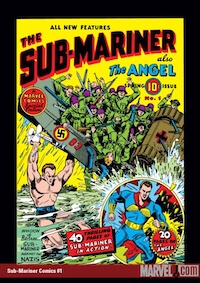 Namor in the Golden Age
Namor in the Golden Age
With the success of Marvel Comics #1 and subsequent issues, superheroes like the Sub-Mariner and the Human Torch became hits for Timely Comics. Bill Everett and Alex Schomburg joined forces in 1941 for the Sub-Mariner’s first solo title which lasted until 1955.
With the start of World War II, Everett shifted his anti-hero’s focus to fighting facism instead of Americans at home. With the launch of Captain America by Joe Simon and Jack Kirby around this time, Timely launched a team book later that year called All Winners Comics in which the earliest version of the Invaders made their debut. In these issues, Namor fights alongside Captain America, Bucky, the Human Torch, Toro, the Whizzer, Destroyer, Angel, and Black Marvel as they battle in Nazi Germany.
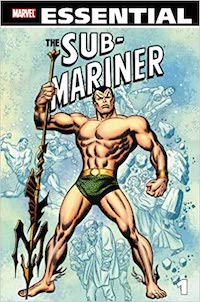 Namor in the Silver Age
Namor in the Silver Age
Stan Lee repurposed handfuls of heroes for Marvel Comics during his day, as evidenced by the presence of characters like Thor, Loki, Hercules, and Captain America but the first was Namor, who was reintroduced into the Silver Age of Marvel Comics in 1963. Sub-Mariner comics had been off the shelves for more than eight years by that point, so Lee and Kirby played into his disappearance. In Fantastic Four #4, Johnny Storm seeks refuge in a shelter only to have a run in with the king of the ocean who has been suffering from a case of amnesia. Homeless, ragged and depowered from too much time on land, Namor finally remembers who he is with help from the Fantastic Four’s youngest member.
After he’s returned to the ocean, Namor quickly remembers who he is and rushes back to his home only to find it’s been destroyed by radiation. Again, cursing humans, he vows revenge on the world above. Calling behemoths from below to destroy New York, Namor is only temporarily distracted when the Invisible Girl, Sue Storm crosses his path. Enamored, he vows to stop the assault if she agrees to become his bride.
Over the next two years, Lee and Kirby brought Namor back regularly, not only in the pages of Fantastic Four — where Sub-Mariner teams up with the likes of Dr. Doom (Fantastic Four #6) and shares more details on his war with humanity and the history of Atlantis (Fantastic Four Annual #1) — but in comics like Strange Tales, Tales to Astonish and newer books the pair were creating like Daredevil, The Avengers and X-Men. In his first encounter with the Avengers, Namor teams up with the Hulk, and later in Avengers #4, becomes indirectly responsible for helping free Captain America from being frozen in ice. You can find all of these stories and more from the first few years of Silver Age Marvel Comics, collected in Namor, the Sub-Mariner Epic Collection: Enter the Sub-Mariner.
After Stan Lee and Gene Colan’s long run on Tales to Astonish, featuring Namor and the Hulk, the Sub-Mariner was given his own book in 1968 which ran for more than 70 issues. In 1972, after years in and out of the Marvel offices, Bill Everett returned to work on the Sub-Mariner with issue #50. It was regarded as some of his best work with the character and he stayed on the book until his passing in 1973.
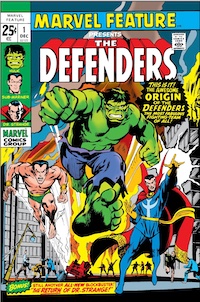 Namor in the 1970s
Namor in the 1970s
In 1971, Ross Andru and Roy Thomas created the temporary team up of Namor, the Hulk, Silver Surfer and Dr. Strange, dubbing the team “The Defenders.” Fans loved their debut in Marvel Feature #1 and the team was given a title written by Steve Engleheart and penciled by Sal Buscema. Defenders ran for more than 12 years until it finally ended in 1985 and by that time its central heroes including Valkyrie, Hawkeye, Nighthawk, Luke Cage, and Clea had cycled through the roster. In Defenders #84 from 1980, Namor and Black Panther face off for the first time after the Black Panther captures Atlantean soldiers involved in purchasing stolen Wakandan technology.
Just a few years prior to the Defenders, Thomas and Sal Buscema had relaunched the Invaders in the pages of Avengers #71. The story, which included flashbacks of a battle that took place during World War II, would eventually get picked up as the ongoing Invaders title in 1975. Marvel Comics’ Invaders, which was also written by Thomas and penciled by Frank Robbins, would last until 1975 and showcase adventures featuring Namor, Captain America, Bucky, Toro and the Human Torch from the 1940s.
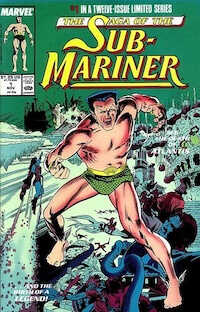 Namor in the 1980s
Namor in the 1980s
Namor starred in two standalone series in the 1980s starting with 1984’s Prince Namor: The Sub-Mariner. The four-issue run, created by J.M. DeMatteis and Bob Budiansky, follows Namor as he travels to New York to petition the United Nations to grant Atlantis membership.
A few years later in 1988, Roy and Dann Thomas and penciler Rich Buckler created the 12-issue Saga of the Sub-Mariner, which aimed to smooth out all of the continuity and fill in any holes. Recapping the history of Namor, Roy Thomas tells the ancient origin of undersea Atlantis, the rise of Namor’s species Homo Mermanus, Kamuu’s empire, Lemuria and the Serpent Crown, all leading up to 1920 and the meeting of Princess Fen and Leonard McKenzie that results in the birth of Prince Namor.
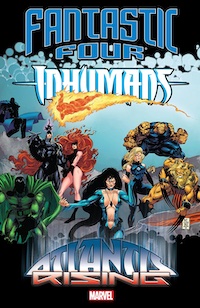 Namor in the 1990s
Namor in the 1990s
Namor went through his biggest stylistic change yet in 1990 when John Byrne took over writing and art duties on Namor, the Sub-Mariner. Byrne applied his sleek look to Namor and brought him out of the ocean and placed him inside the boardroom, acting as CEO of Oracle Inc. Throughout the run, Namor flexes his financial muscles as well as superpowers to help clean up the ocean and fight off both monsters and corporate magnates. Fun fact: Byrne also revives the long dead Danny Rand as Iron Fist halfway through the run.
Towards the end of Byrne’s run, in 1995, the story crossed over with the Fantastic Four to deliver the Atlantis Rising arc. Crisis strikes as sorceress Morgan Le Fay forces the sunken continent of Atlantis back above the waves. Namor and The Fantastic Four race to help the stranded Atlanteans while Thor and the Inhumans become ensnared in the witch’s trap.
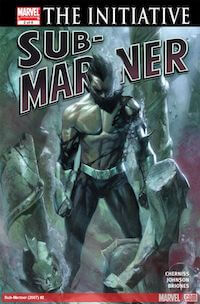 Namor in the 2000s
Namor in the 2000s
After the comic book crash of the late 1990s, the early 2000s brought a lot of reboots and reinterpretations for many of Marvel’s characters. In 2001, writer Grant Morrison and artist Jae Lee created Fantastic Four 1 2 3 4, which gave each superhero their own chapter for reflection as it examined the first family of Marvel. Of course, Namor shows up to woo Sue and terrorize Reed.
Towards the end of the decade, and the start of Brian Michael Bendis’ run on Avengers, Namor stepped up to scheme in the shadows as Civil War overshadowed the Marvel Universe and then the Dark Reign of Norman Osborne began. In Sub-Mariner: Revolution, Namor is reintroduced in a story by Matt Cherniss and Peter Johnson which has him running into some of Marvel’s heavy hitters including Wolverine, Venom and Dr. Doom. This run also features a slate of stunning covers by Leinl Yu, Gabrielle Dell’otto, Michael Turner, David Finch, and Marko Djurdjevic.
On 2009, Namor got another relaunch as writer Peter Milligan and artist Esad Ribic took on Sub-Mariner: The Depths for Marvel Knights. The story, told from the viewpoint of legendary adventurer Randolph Stein, sheds light on Namor’s home of Atlantis in the dark depths of the sea.
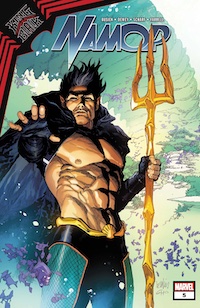 Namor in the 2010s and beyond
Namor in the 2010s and beyond
After Dark Reign, Namor joined the X-Men alongside Emma Frost and Magneto and with the relaunch of X-Men in 2011, the Sub-Mariner was given his own series once again. This time, Namor: The First Mutant (written by Stuart Moore and illustrated by Ariel Olivetti) focused on Namor’s lineage as a mutant and his relationship to Thakorr and the X-Men.
Namor spent most of the next few years joining and then defecting from several Marvel teams including the Illuminati, the New Avengers, the Squadron Supreme, and new versions of the Defenders and Invaders. More recently, Namor spent a turn as a supervillain in Jason Aaron’s Avengers run and the reboot of Invaders written by Chip Zdarsky. After a small cameo in House of X/Powers of X, writer Kurt Busiek alongside artists Ben Dewey and Jonas Scharf returned to Namor’s youth with the mini series King in Black: Namor.
Finally, if you’re looking for something super fresh, in October, Marvel released Namor: Conquered Shores by Chris Cantwell and Pasqual Ferry, which shows the undersea king 100 years in the future.
Dana Forsythe is based in Boston and is a longtime reporter covering art, comic books and culture.







































